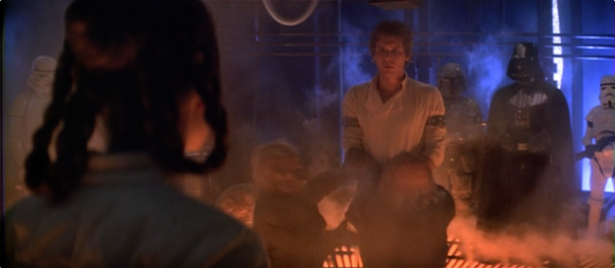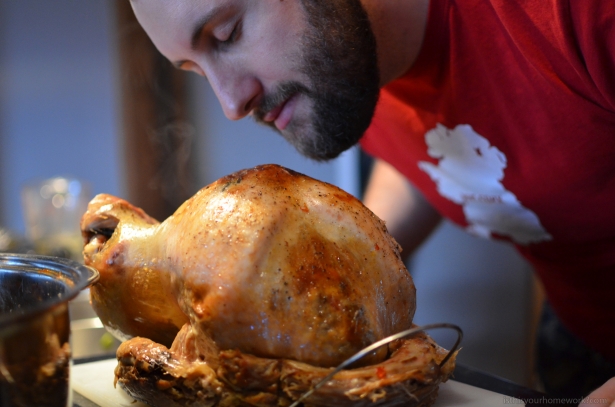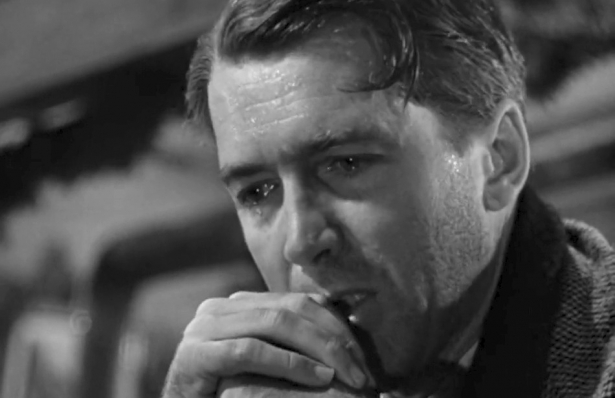“I know.” Two words, famously ad-libbed by Harrison Ford after many repeated takes of the scripted “I love you too” line. Two words that evoke love far more powerfully than any hallmarkian sentiment in this or any other galaxy. In all of cinema, in all its rich and romantic history, “I know” is certainly the most romantic ad-lib. And in my estimation, “I know” is high among the most romantic lines, full stop.
From Leia’s perspective, Solo’s pursuit had seemed not motivated by love, but perhaps by a mere desire for conquest.
It is in one of the darkest moments of The Empire Strikes Back, in all of the Star Wars franchise really, when Han Solo replies with those two little words to Leia’s tearful and frighted admission of “I love you.” And in that moment we witness a breaking of character. Not merely the breaking of the fourth wall by Ford with his ad-lib, but the abandonment of a mask behind which Solo had been hiding for so long.
At first blush, it might sound in-character for Solo. Another in a long line of the snappy repartee that had characterized his and Leia’s relationship. But it was more than that. His was a naked and vulnerable return of her statement of love.
Up to that point their relationship had been adversarial, full of romantic friction. Solo had been pressing his suit with Leia, but in a ‘scruffy’ sort of way, the way a scoundrel would. From Leia’s perspective, Solo’s pursuit had seemed not motivated by love, but perhaps by a mere desire for conquest.
A whisper of breeze ruffled the airfield’s August-browned grass. The sky overhead was warm and inviting. With unlimited visibility, the bright blue canopy appeared as if it had pulled back from the earth to provide extra airspace beneath. One lone cotton-cloud lazed over the horizon. Two eagles circled effortlessly high overhead. It was a perfect day for flying.
Pilot Rod Rees strode across the lawn. A young man in the Summer of 1963, my Uncle Rod was little older than I was when I first heard the story of his maiden flight. My mother Arlene, only a girl then, saw no trace of fear as her older brother approached the field. His eyes were set, his face was determined, and his aircraft was slung confidently under his arm.
After weeks waiting for the kit to arrive, after a summer holiday spent indoors on painstaking assembly, after his fingers had become calloused from fine tooling and his lungs ravaged by glue fumes, the day had finally come for his dream to take flight.
Aircraft fuelled and pre-flight checklists completed, Rees glanced yet again at the listless pine-bough windsocks overlooking the R-Bar-Eagle farm’s upper horse paddock —newly rechristened the Galiano Island Airfield. He bent low over his aircraft and, with a high whine and a puff of blue smoke, the engine coughed to life. Rees cycled the controls and adjusted the radio’s trim knob one last time. He looked up, taking two half-steps backward.
The plane burst forward.
Turkey, turkey, turkey! Here it is, my mother’s amazing turkey dinner recipe, straight from the source [with my notes added in brackets].
I know that everybody’s partial to their mother’s cooking, but my mom’s turkey dinner is always outstanding! It’s her secret weapon for getting me over to the Island to visit. I’m a horrible son. (Sorry Mom!)
It’s not as specific as a cook-book recipe, but it doesn’t need to be. Anybody with a cook’s soul should breeze through it (chef-ery not required). Post your questions, and I’ll answer below. (My Mom may even too!)
Stuffing
- italian bread, extra long sliced loaf [D'Italiano works great, so do more squirrely breads]
- onion
- garlic
- celery
- italian sausage [Costco hot italian is outstandingly good italian sausage for any recipe!]
- mushrooms [I use white, but you can use whatever floats your boat]
- red pepper
- eggs
- salt
- pepper
- sage
- poultry seasoning
- butter
- olive oil
Make sure that you freeze the loaf of bread ahead of time so that it is easy to cut into cubes without it getting squishy.
Put some olive oil and butter in a large saute pan. If your italian sausage is in casing, remove and crumble into pan as many to taste, say 5 or 6 for a full loaf of bread [I use 4 or 5 of the big Costco sausages, about 600-700g]. Add onions and brown along with sausage.
In the meantime finely chop one or two celery stalks, loads of garlic, and as many mushrooms as you like [I use lots, you can't have too many!].
When the sausage is browned, turn down heat and add the celery, garlic, mushrooms, some more olive oil and too much butter for anyones good. I use lots of butter as it gives a nice flavour [It's turkey dinner, leave your food-conscience at the door!]. Add quite a lot of sage – again to taste – bearing in mind it will diffuse through the bread so if it seems too strong, it probably wont be. I’d say about 2 tablespoons at least, maybe more. Add about the same, or a little less in poultry seasoning. Grind in some pepper, but don’t use too much salt as the butter is salty. Also at this time add water to the pan, enough to make it all quite moist but not soupy.
He prepared the explosives with slight care, quickly, casually, the ritual well-practiced, components proportioned more or less precisely, burner tuned just-so to an unmarked setting, the steel lid lowered for even heating and explosive containment.
Sirens sang, foreboding shrieks and squawks and shearing sounds, as the vessel was shaken and slid across the element, stirring untouched its contents. Intermittently the concoctor ceased his agitation and crooked an expert ear to the silence, listening for sizzling, steady but not slow, energetic but not angry. It mustn’t burn. Burning meant acrid smoke, accusatory smoke, overpoweringly aromatic smoke, smoking evidence that lingered, alerted the neighbours, testified to his activities, testified to his inexpertise.
An explosion surely overdue, his doubts began to mount. Was it too hot? Not hot enough? Was this batch going to explode? *pop* The first explosion always a surprise, always a relief. *pop-pop-pop* The explosions came faster, faster still. The tin-can rat-a-tat-tat of the popping startled his senses, stimulating salivation before sent was detected.
Still shaking, sliding, stirring the pot, he watched, trance-like, the stochastic explosions sending kernels careening, chaotically clanging and caroming off the pot with each pop, pop, pop.
Eyes drying and mouth watering, he stood mesmerized by the turmoil. Blasted blossoms burst like frozen fireballs, each concussion showering the seething mass with corn-husk shrapnel, triggering secondary and tertiary explosions as ticking time-bombs tumbled.
At last the cacophonous barrage began to abate. But not the stirring, shaking, sliding. He knew the risk of burning was highest now, knew that explosive packages had to be sifted toward the heat, had to be detonated before the now-dry pan overheated.
Three seconds. Three seconds without a pop was all that could be afforded. One—*pop* The clock reset. One…*pop* Reset. One… two…*pop* Reset again. One… two…*pop* Too long, three seconds was too long this time. One… two… —burning, it was going to burn— three! He doused the burner, threw back the lid, and dumped the steaming contents into the waiting container.
Perfect popcorn.
Read the rest of this entry »
If you haven’t ever seen It’s a Wonderful Life, or even if you have seen it, but don’t remember it well, do yourself a favour and go watch it. It is one of those somewhat rare classic films which still holds up amazingly well today. More than that, it isn’t at all the sappy, corny movie that most people assume it is or mis-remember it as.
Far from the cinematic snow-globe that most people mis-categorize it as, It’s a Wonderful Life is surprisingly dark, very witty, and truly entertaining.
Whether they’ve seen it or not, most know it for Jimmy Stewart as George Bailey running through Bedford Falls, yelling “Merry Christmas!”; and of course for the sacharine-sweet Zuzu proclaiming “Teacher says, every time a bell rings, an angel gets his wings!”; all culminating with the tearful reprise of Auld Lang Syne. Those are the images that everybody –everybody who doesn’t remember the film well– recalls immediately upon hearing its name. And I’d agree, if those scenes were indicative of the overall tone of the movie, it would indeed be a sappy mess, hardly worth watching, save for when you desperately need a simple and sweet bit of holiday fluff.
But that is not the feel of the movie! Far from the cinematic snow-globe that most mis-categorize it as, It’s a Wonderful Life is surprisingly dark, very witty, and truly entertaining. The film is thoroughly rewarding even to more refined modern-day audiences. And while it has been elevated to Christmas canon, very little of it actually occurs around Christmastime, and it certainly isn’t your standard holiday fare.
The first two hours of the film are a long, dark study in the psychological torture of George Bailey.
The reason for the dissonance between the perception and the reality of the film is obvious; for decades television network and advertising executives have slavishly adhered to the Law of Classic Films, the law mandating that all, and only, the most clichéd moments of classic films must be repeated, ad nauseum, in every advertisement or reference to said films.
What makes It’s a Wonderful Life such a surprise to the first-time viewer is that, while its runtime is a hearty 130 minutes, all of those oft-remembered, oft-rehashed, and awfully sweet moments occur in the final 7 minutes of the film. While the final few minutes are indeed a super-concentrated distillation of the essence of Christmas, they serve as a well-balanced counterpoint, a satisfying glaze, too sweet on its own, but just perfect as the topper to the body of the film. These clichéd, over-sweet moments work so beautifully well, because the first two hours of the film are a long, dark study in the psychological torture of George Bailey.









